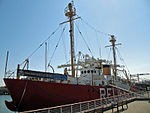Port of Oakland
Economy of Oakland, CaliforniaGeography of Oakland, CaliforniaPolitics of Oakland, CaliforniaPorts and harbors in the San Francisco Bay AreaPorts and harbors of California ... and 2 more
San Francisco BayTransportation in Oakland, California

The Port of Oakland is a major container ship facility located in Oakland, California, in the San Francisco Bay. It was the first major port on the Pacific Coast of the United States to build terminals for container ships. As of 2011 it was the fifth busiest container port in the United States, behind Long Beach, Los Angeles, Newark, and Savannah. Development of an intermodal container handling system in 2002 culminated over a decade of planning and construction to produce a high volume cargo facility that positions the Port of Oakland for further expansion of the West Coast freight market share. In 2019 it ranked 8th in the United States in the category of containers.
Excerpt from the Wikipedia article Port of Oakland (License: CC BY-SA 3.0, Authors, Images).Port of Oakland
Market Street, Oakland
Geographical coordinates (GPS) Address Nearby Places Show on map
Geographical coordinates (GPS)
| Latitude | Longitude |
|---|---|
| N 37.795533333333 ° | E -122.28460277778 ° |
Address
Market Street
Market Street
94607 Oakland
California, United States
Open on Google Maps






